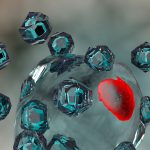Invisible toxins in food can damage your health
 (NaturalHealth365) You can’t see, smell or taste them – but for many years silver nanoparticles have been added to our food supply (and medications) at an alarming rate. Like me, I’m sure you’re wondering why would food producers – and the pharmaceutical industry – place silver in their products?
(NaturalHealth365) You can’t see, smell or taste them – but for many years silver nanoparticles have been added to our food supply (and medications) at an alarming rate. Like me, I’m sure you’re wondering why would food producers – and the pharmaceutical industry – place silver in their products?
Sadly, the media loves to portray this idea of using nanoparticles as ‘no big deal.’
But, to be perfectly clear, we – at NaturalHealth365 – think that consuming silver nanoparticles is a bad idea. These particles are sprayed onto produce – as a pesticide – and incorporated into food packaging to extend shelf life, due to their antimicrobial properties. And, we’re not the only ones sounding the alarm.
Scientific research warns us that the uptake of these tiny particles can cause cellular damage, kidney disorders, stomach upset, headaches, fatigue and skin irritation.
Nanoparticles will NOT help you to “age gracefully”
Researchers have demonstrated the devastating effects of silver nanoparticles on cell survival, and the integrity of the mitochondria.
For example, animals treated with silver nanoparticles exhibited reduced cognitive/motor functions and altered cellular structures in the brain. And, just to be clear, many scientific studies suggest that chronic exposure to silver nanoparticles can damage brain function.
Simply put, with all the other pollutants in our environment, should we really allow this kind of technology to contaminate our food supply?!
Science clearly reveals an alarming (toxic) trend
Further data shows silver nanoparticles induce toxicity in neurons with the resulting dysfunction of physiological function. These particles, once digested, get distributed inside the brain, heart, and blood – which can result in cardiac arrhythmia, slower blood flow and impaired motor skills.
Observations, in laboratory animals, have shown that the uptake of these particles – in the digestive tract – can change the terrain. As you know, the digestive tract harbors beneficial bacteria along with pathogenic bacteria. But, silver nanoparticles can wipe out the “good” bacteria along with toxic ones.
Naturally, if you disturb the healthy balance of bacteria, within our gut, you compromise the immune system – setting the stage for chronic disease.
Scientists detect unwanted toxins on our fruit supply
Scientists developed a new method for detecting silver nanoparticles in food during a study published in the Journal of Agricultural and Food Chemistry. This method was able to identify and measure relatively small amounts of these nanoparticles, in pears, according to Mengshi Lin, Ph.D. – study author and associate professor of food science at the University of Missouri.
The pears were immersed in a silver nanoparticle solution, similar to a pesticide application, and then washed and rinsed repeatedly. Four days after the treatment and rinsing, the silver nanoparticles were still attached to the skin and some even penetrated the skin to reach the pear pulp.
In addition, many food packing materials incorporate silver nanoparticles to prolong the shelf life of packaged foods. The nano material has been known to transfer to the food – inside the package. I hope, after reading this, you’ll feel even better about eating fresh (unprocessed) food – as much as possible.
Keep in mind, nanoparticles can become airborne easily due to their size and mass. When inhaled, nanoparticles can go deeper into the lungs reaching more sensitive areas. These particles can inflame the lungs – which must work harder in attempts to remove the foreign particles.
The only known protection from nanoparticle toxins
It takes an incredibly small amount of this substance to cause health problems. In fact, the Food and Drug Administration (FDA) is on record saying that nanoparticles pose safety issues – because they significantly alter bioavailability properties of food, which alter how much your body can absorb a substance. This means it affects the amount of nutrients you absorb and the amount of toxins that can enter a cell.
Unfortunately, companies aren’t required to label or test nano materials in the food they sell you or the packing they put it in. To counter the ever increasing amount of nanoparticles in food – you have to look for whole (unprocessed) foods, which aren’t commercially packaged. We’re talking about: apples, carrots and dark leafy greens. In terms of animal foods … only eat small amounts of wild caught fish or grass-fed, pasture-raised eggs, chicken and beef.
Buy local (whenever possible) – since foods that are transported long distances are often treated with nanosilver particles to keep them looking “fresh.” Organic produce is less likely to be treated with nanoparticles. Plus, we know that organic farming techniques avoid the use of sewage sludge fertilizer – which can be tainted with nanoparticles.
Thankfully, the world is changing and people are waking up to the truth about toxic food, medicine and personal care products. Vote with your dollars and be part of the solution. The rewards are worth the effort.
Sources for this article include:



